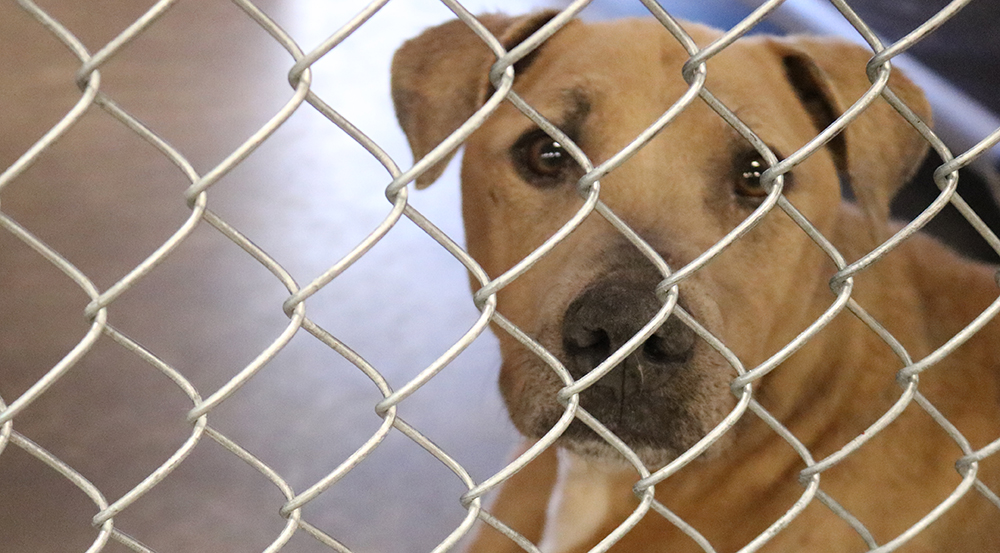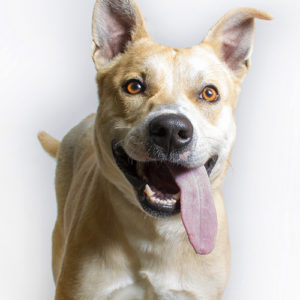We recently featured Periwinkle,
an adorable blonde hound who had been waiting in our shelter for over 100 days. We were becoming concerned with his increased kennel reactivity and wanted to make sure that he found a home soon. Periwinkle is a very sweet and gentle dog. We learned that about him quickly. Like many of the animals here, he did not deserve the long wait that he has had with us to find a forever home. His playful attitude and gentle disposition and cute hound dog appearance would seemingly make him a great pet for somebody! Instead he has waited patiently here for adoption while becoming more kennel reactive every day. But what does ‘kennel reactive’, also referred to as ‘barrier reactive’, actually mean?
Watch Periwinkle’s video for an example of kennel reactivity.
How Does a Dog Become Kennel Reactive?
Many dog breeds have evolved over time to become very specialized to capitalize on their genetic traits. Take K-9 dogs, for example. Their job is to sniff out contraband. Routinely tasked with finding this contraband, these dogs can become frustrated and even suffer from depression if they are unable to locate any contraband. To offset these conditions, trainers will provide these dogs with ‘patsy’ contraband to find. The dogs can then successfully feel like they have completed their task and relax. Similarly, many breeds of dogs are not meant to spend extended amounts of time in a kennel environment. It is hard for even the most even-tempered dog to withstand the frustration of seeing people and other dogs continually walk past their kennel door.

An animal shelter is just that -shelter for animals that need it. It is not a home. It is not a pet store. It is, at its best, a temporary solution for animals that need a permanent home. We get attached to the animals that we care for. That goes with the territory. We want the very best for our animals -both while they are here with us, and once they are adopted. Part of safely and humanely housing a large number of animals requires the use of kennels. This is a necessary element to ensuring each animal has safe, comfortable, and adequate housing. This, however, is a double-edged sword.
Symtoms of Being Kennel Reactive
Dogs are social animals by nature and having a barrier between themselves and the rest of the world has a very real emotional and psychological impact on many dogs. This impact on their psyche manifests itself as behavioral changes within the dog. This is the cause of kennel reactivity. Barking, growling, and whining are some of the most common and easily identifiable behaviors that can occur when a dog becomes kennel reactive, though other unwanted behaviors such as aggressive jumping and biting, can also present. It is a very difficult thing to see happening to a dog that you know to be a gentle and generally well-adjusted animal such as Periwinkle.

It also makes it all the more difficult to find a family and a home for a dog that has become barrier reactive. The public at large may not be familiar with the effects of kennel reactivity and assume the dog’s behavior while in a kennel as being indicative of their actual disposition. It is all too common for potential adopters to overlook kennel reactive dogs due to this assumption. After all, who would want to adopt a dog that is going to aggressively bark, growl, lunge? And so, problem of kennel reactivity self-perpetuates. The dog becomes more reactive, and the more reactive it is, the less adoptable it appears, the more time it spends in the kennel, the more kennel reactive it becomes, and so, on and on it goes.
A Solution for Kennel Reactive Dogs
There is a wonderful truth about this, though. Kennel reactivity can be counter-acted. The fix is a simple one. Remove the afflicted animal from the kennel for good. A normal, healthy household is what a dog needs. A loving and active lifestyle that permits the animal to behave naturally. A focus on socialization with other dogs, and properly training these dogs for walking on and off leash around other people and animals can heal a dog of its kennel reactivity. Periwinkle is a great example of this! Our spotlight video featuring him shows both his true nature; running, playing, and happy, as well as how he exhibits reactivity in his kennel. His prolonged stay within our kennels was a growing concern for all of us who have had the joy of interacting with him. We wanted to find him a home, and soon.
UPDATE
Periwinkle has been adopted! He is on his way home and on the road to recovering from his kennel reactivity. We hope more people will become aware of what it means for a dog to be kennel reactive. Behind these symptoms is a dog that simply needs a loving home.

